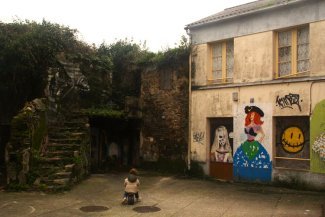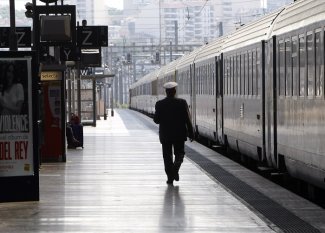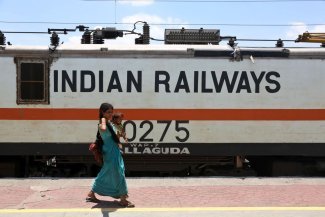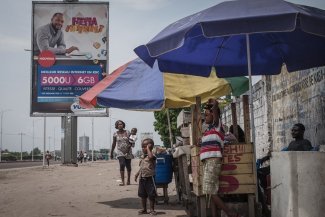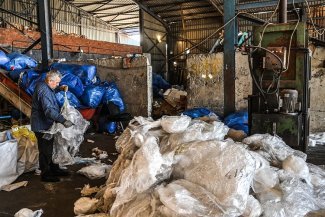
A Croatian Railways (Hrvatske željeznice) commuter train journeys through Kaštel Stari in Croatia. Like elsewhere in the region, the long-term lack of investment in Croatia’s railways has led to a decline in both its total length of rail lines and the maximum speed of trains.
In his 1930 book Train in the Snow (Vlak u snijegu), Croatian writer Mato Lovrak tells the story of a group of schoolchildren who travel to a nearby town for a field trip. As they are supposed to return to their village, their teacher falls ill, and the children travel home on their own. When the train gets blocked by a snowdrift, the children work together with railroad workers to unblock the track. Almost a century later, one could say that the popularity of the book has outlived the popularity of railways. While the novel is still widely known as a warming tale of solidarity and friendship, the concept of (school) trips by train have become a rarity.
The long-term lack of investment in Croatia’s railways has led to a decline in both its total length of rail lines and the maximum speed of trains, which negatively affects both passenger and freight traffic. When in 2014 the Croatian railway company, Hrvatske željeznice (HŽ) took to social media to ask its followers to come up with its new slogan, it received suggestions such as: “Speed isn’t everything” or “Is your life too fast? Then travel with HŽ”. These tongue-in-cheek responses provided an insight into how the national rail service was perceived at the time: slow, unreliable and outdated. Almost ten years later, that perception hasn’t changed.
But Croatia is not an exception in the Balkans.
Across the countries of the former Yugoslavia, the railways have deteriorated due to huge cuts in investment, the slashing of services and staff numbers, and the poor maintenance of crumbling infrastructure.
While in Yugoslavia, the national railway companies were integrated in a consortium called the Yugoslavian State Railways (Jugoslavenske državne željeznice), today, the region’s railway system is a patchwork of different companies, operating in markets that have been liberalised to varying degrees. Most of the former Yugoslavian capitals are no longer connected to each other by rail, while, when it comes to the total length of the railway lines in use in Europe, North Macedonia, Bosnia and Herzegovina and Montenegro are at the very bottom of the list.
In recent years, new development projects in the railway sector have been announced across the region. But the pace of modernisation is still slow, and some fear that further liberalisation of the market will spell trouble for local companies and passengers.
‘Not a priority’
When Lovrak wrote his children’s book over 90 years ago, Croatia still boasted a rail network that was on par with some richer Western European countries. The major part of the railways in today’s Croatia were built in the period up to the First World War, when Croatia belonged to the Habsburg monarchy. During the periods of the Kingdom of Yugoslavia (before World War Two) and Socialist Yugoslavia (after 1945 and until the 1990s) different parts of newly united countries were connected by railway.
But war in the 1990s left the railway systems destroyed, neglected, and more fragmented. The instauration of new borders between countries meant that a bigger international coordination of railway traffic was required, but funds for modernisation were lacking. For Fikret Ljevo, the current president of the Independent Trade Union of Railway Workers of Bosnia and Herzegovina (Samostalni sindikat željezničkih radnika u Bosni i Hercegovini) based in Sarajevo, the railway systems before and after the war in Yugoslavia represent “two different worlds”. Speaking during a phone interview with Equal Times he said: “What we have today doesn’t even look like a proper railway. When I joined the railway company in 1984, many train stations used technology they no longer have. Today, in many parts of the rail network, a train needs to notify the station of departure when it arrives at the end station, so that the next train can leave the station. That was automatised before,” he explained.
Today, Bosnia and Herzegovina has a total rail length of just over 1,000 kilometres – a decline compared to 100 years ago, when it was 560 km longer – and the average speed of its trains is about 50 km per hour. There are no high-speed train lines in the country.
Croatia, with its 2,600 km of railway, doesn’t fare much better. “The maximum allowed train speed is on average 41-60 km/h, while the highest speed of 140-160 km/h is possible on only 4 per cent of the total railway network,” says Nikolina Rajković, a researcher from the Institute for Political Ecology (IPE), a multi-disciplinary research non-profit based in Zagreb, Croatia. By comparison, countries such as France, Italy, Germany and Spain have some of the fastest trains in the world, with speeds reaching 300 kilometres per hour.
In its study Our Railways, published in 2020, IPE looked into the structural reasons behind the decline of railways in the country. Researchers noted that the slow decline of the Croatian railways had already started in the 1960s and 1970s, with a national restructuring policy that resulted in closure of lines and train stations.
When national infrastructure was being rebuilt after the war in the 1990s, road infrastructure was treated as a priority. According to Rajković, Croatia’s current national strategy for transport development until 2030 is exceptionally poor when it comes to the railways. “It doesn’t offer any clear and concrete solutions. For example, we do not see growth projections of rail traffic compared to road traffic,” she explains.
New investment but rail modernisation still lagging behind
The Balkans are not an exception when it comes to the prioritisation of roads. While new night train routes have been launched across Europe to much fanfare, behind the headlines lies is a more nuanced picture. An investigation published by Investigate Europe in November 2021 discovered that, on a whole, EU countries still invest significantly more money in roads than railways. They also found that 6,000 km of rail have been decommissioned in the past 20 years, and that instead of using the funds for projects that bring quick and major improvements, EU states had invested billions in inefficient large-scale projects.
In 2019, the EU announced more funding and support would be given to the development of the rail network within the block as well as its neighbouring countries. “The standards and the way that transport is run should be identical from the EU countries to Serbia to Montenegro to Albania. Basically, the region should be integrated into the EU’s transport market, even before the countries join the EU,” explains Matej Zakonjšek, the director of Transport Community, an organisation on a mission to integrate the transport market of the Western Balkans into the EU.
A number of railway modernisation and development projects have come to life across the region in recent years. The European Bank of Regional Development (EBRD) alone participated in the financing of railway projects in the Western Balkans to the tune of nearly €1 billion and is currently involved in 22 active projects, according to Bojana Vlajčić, who heads donor visibility at EBRD in the Western Balkans.
The EU has also stepped in to finance railway modernisation. In Serbia, the largest sum of non-refundable EU funding yet (€600 million) has been allocated to the reconstruction of the Belgrade-Niš railway.
Some recent projects attracted a lot of controversy, though. In Serbia, the Budapest-Belgrade railway line is seen as increasing Chinese influence in the country, but also as a financial burden for both Hungarian and Serbian tax payers, who will foot the bill for the Chinese loan. The total cost of the railway is a whooping €3.8 billion for 370 km of railway, and the completion of the project, initially scheduled for 2018, has been postponed to 2025.
While the needs are many, the modernisation process can be quite slow, says Zakonjšek. “The level of complexity when it comes to the railway infrastructure projects is quite high, even if money was not an issue. But funds are not unlimited. Moreover, the Covid pandemic and inflation has made everything more expensive, and the complexity is even higher in the region where countries don’t have an established legal and technical framework similar to the EU one,” he says.
According to EU rail transport policy, all countries joining the EU have to adopt four packages aimed at opening railway markets to competition, namely, increasing the interoperability of national railway systems, and defining the framework for a Single European Railway Area. This liberalisation is based on requirements such as ‘wheel and track’ separation, meaning that separate management is required for railway infrastructure and its operations in an attempt to foster competition, improve services and decrease prices. But this process often leads to downsizing. In Serbia, which has been an EU candidate country since 2009, Serbian Railways was divided into four different companies in 2015, in order to separate the management of infrastructure and services. After the restructuring, the number of employees gradually decreased. In 2021,10,328 people worked in railway companies; 6,431 fewer people than at the end of 2015.
Croatia: a cautionary tale of liberalisation
Croatia, once had a single railway company, Croatian Railways (Hrvatske željeznice), providing both passenger and freight transportation services. Since 2012, there are four separate companies in Croatia, managing different aspects of railway system (passenger transportation, cargo, railway maintenance and infrastructure). This fragmentation makes them “more susceptible to additional liberalisation and the possibility of privatisation,” says Rajković of the IPE. She adds that Croatia “simply copied the EU Directives concerning railway packages, without thinking how that will impact the quality of service and sustainability of the companies”.
Rajković highlights the example of HŽ Cargo, the national freight transporter which got the short end of the stick during the division of assets after the fragmentation of Croatian Railways. “Today, it has an outdated train fleet and chronic staff shortages. The company is losing money. In all the EU countries that have adopted the railway packages, it is prohibited for the state to subsidise cargo operators. Freight transportation is now operated mostly by foreign operators who account for more than half of the total cargo transportation in Croatia.”
At the same time, joining the EU opened more possibilities to attract EU funding. According to an announcement from April 2023, Croatia could benefit from a hefty €26 billion fund for the modernisation of its railways. But the funding comes with its own set of problems. According to IPE analysis, different actors from the sector have stressed that there was too much dependence on EU funding and that it wasn’t clear to what extent the projects themselves contribute to the railways’ own development goals. “The single European railway market is organised in such a way that it relies on the most economically advantageous offer, which favours certain service providers. Others, due to high input costs, are excluded from the competition because they can hardly compete with large companies. This is usually the case with Croatian companies,” explains Rajković.
The funding is also not likely to be allocated for the upkeep of the existing train tracks, which is crucial for the functioning of the railway.
“Sometimes, ten years are spent working on 50 kilometres of rail. And in the meantime, another 100 kilometres of rail will become defective due to a lack of maintenance,” says Ivan Forgač, president of the Trade Union of Croatian Railway workers (Sindikat hrvatskih željezničara).
“The role of the state is to maintain the existing railways at a certain level of quality, but the maintenance budget is close to zero. The train tracks are repaired and changed when something breaks, but that is a patchy solution. New trains are being bought now, some with EU money, which is good, of course. But if the tracks are not good, the new trains will be as slow as the old ones,” he says.
Forgač believes that the problem stems from a lack of centralised management of the railway sector. In Croatia, the sector is now the responsibility of the Ministry of the Sea, Transport and Infrastructure, which is, according to Forgač, under resourced and understaffed. In fact, a lack of expertise and personnel is an issue throughout the sector. “The interest in railway jobs, be it train conductors, ticket controllers or anything else, is currently very low. We are losing staff, and we are not replacing them with new manpower,” says Forgač. Ever since Croatia joined the EU, many workers have left the country for better paid jobs in Western Europe. The total number of the workers from all the sectors who have migrated abroad isn’t known, but in the period from 2011 until 2021, the country lost over 5 per cent of its population. According to Forgač, many aspiring railway workers might also be tempted to seek jobs abroad, where the salaries are higher and the railways are faster.



